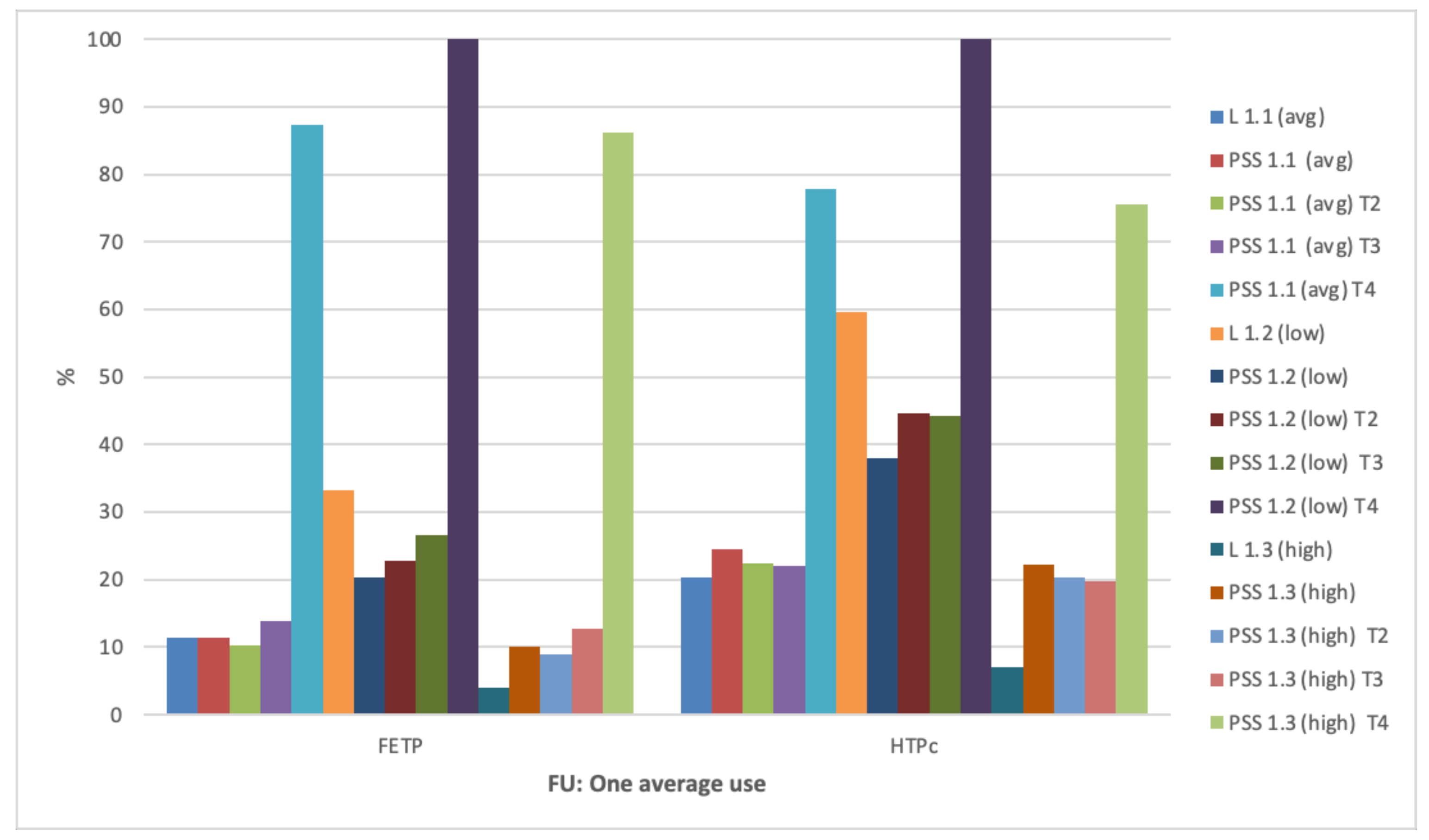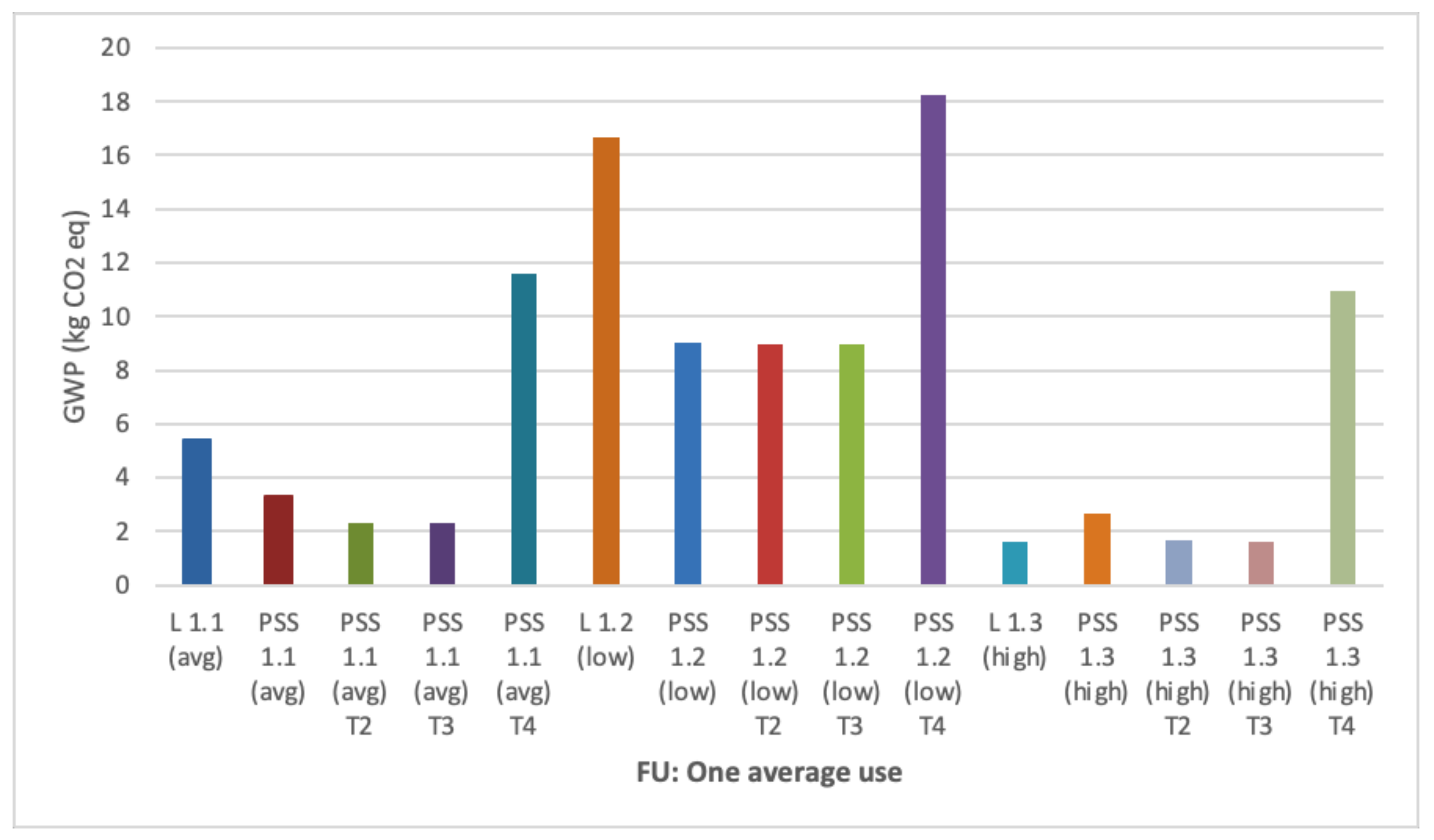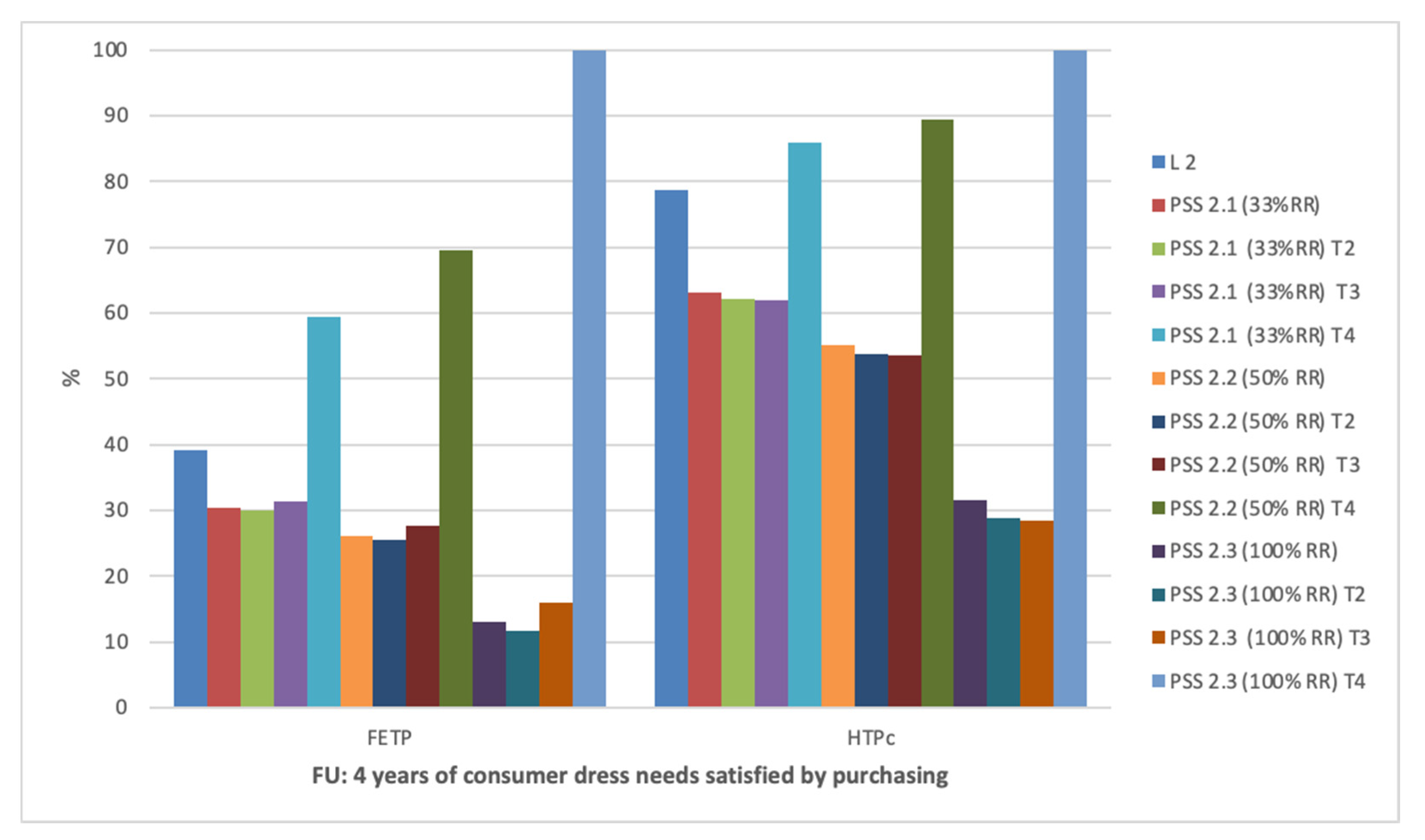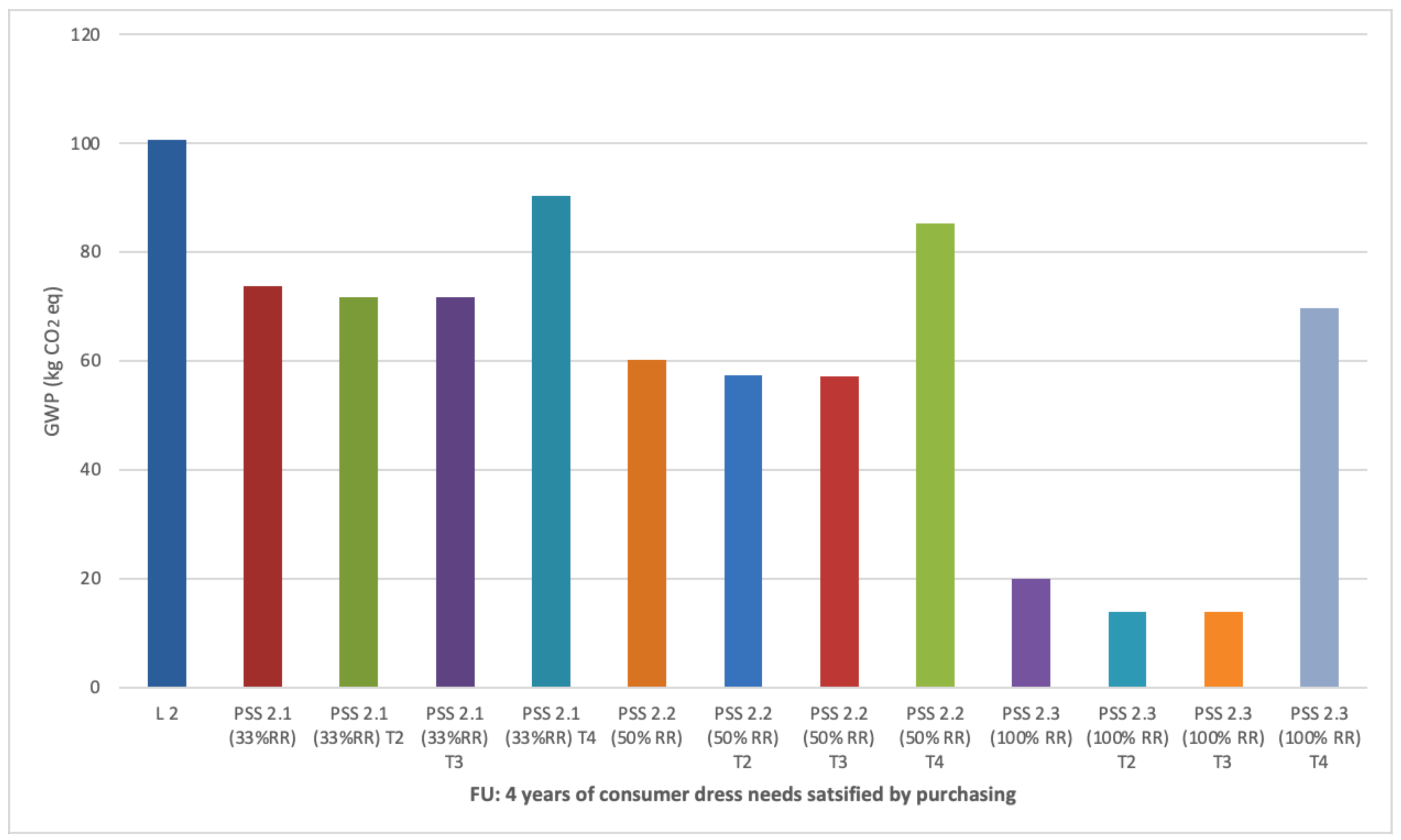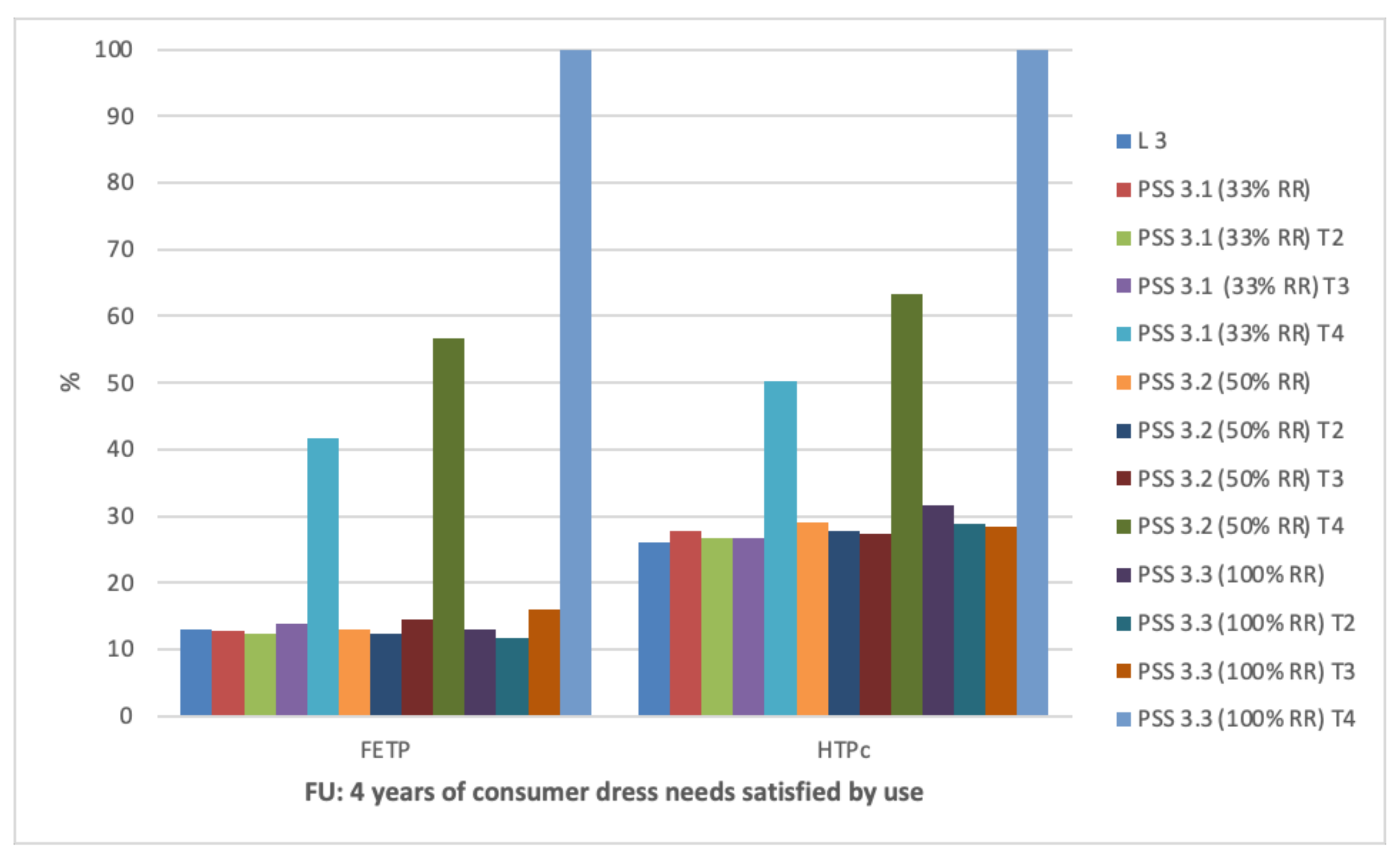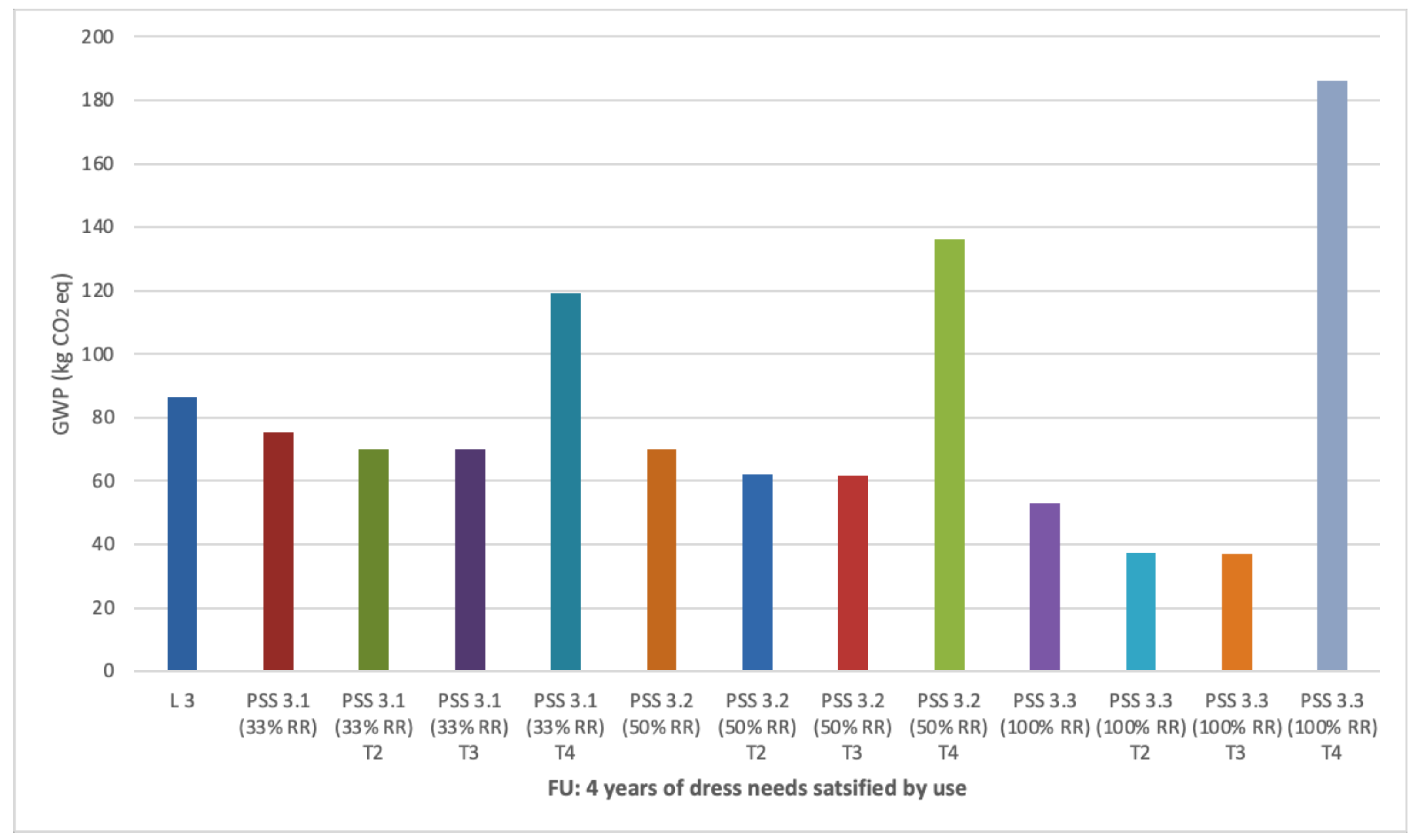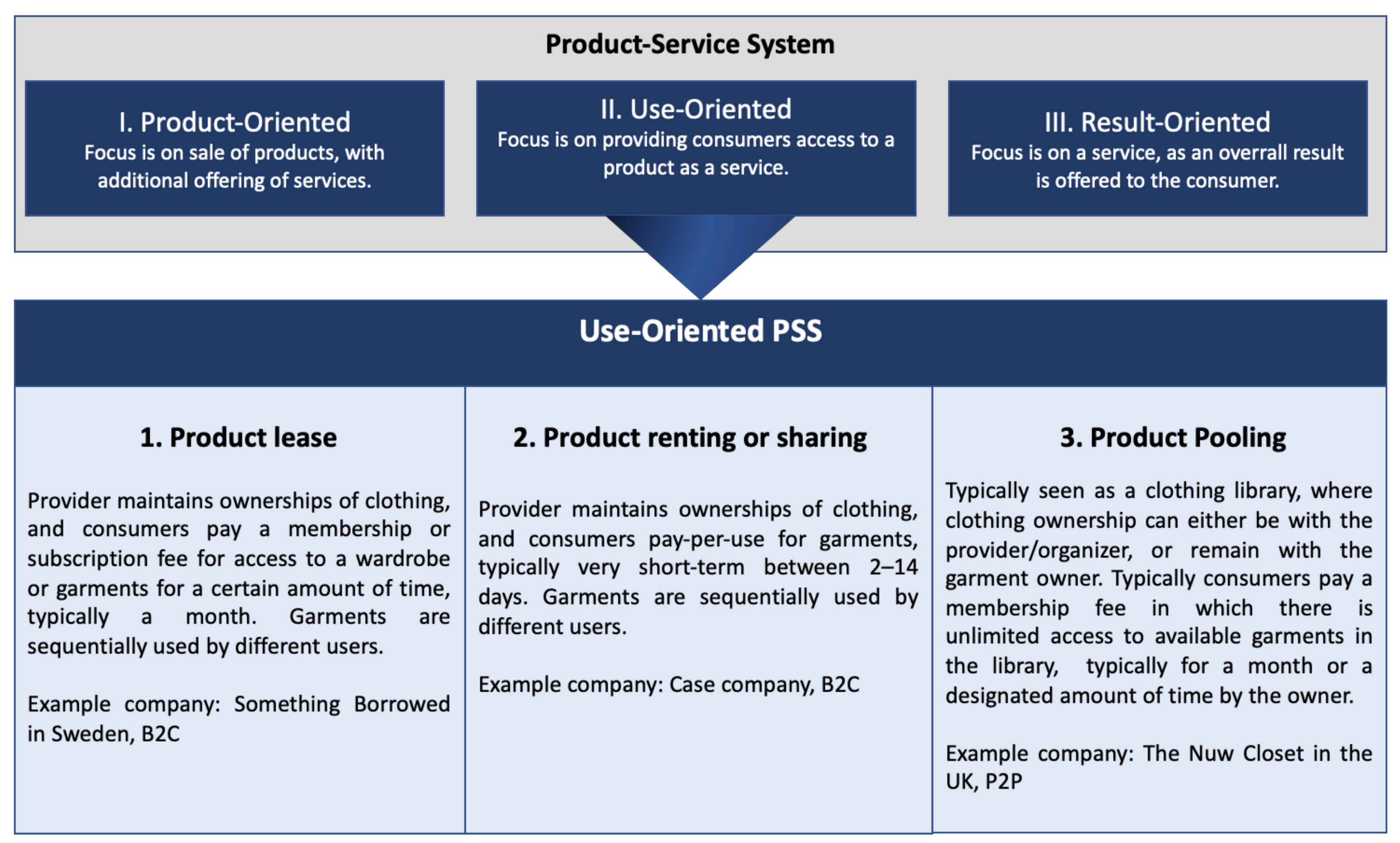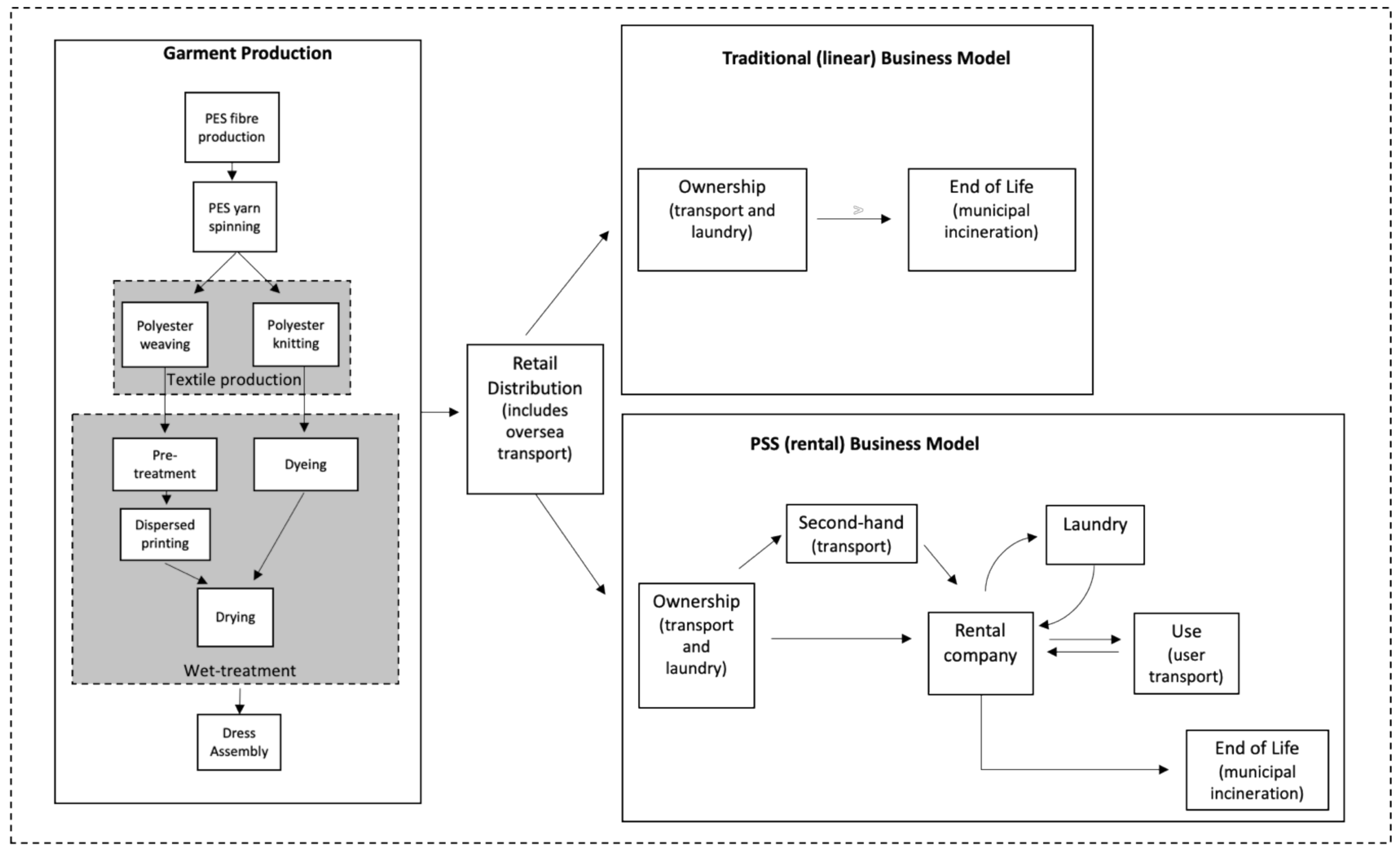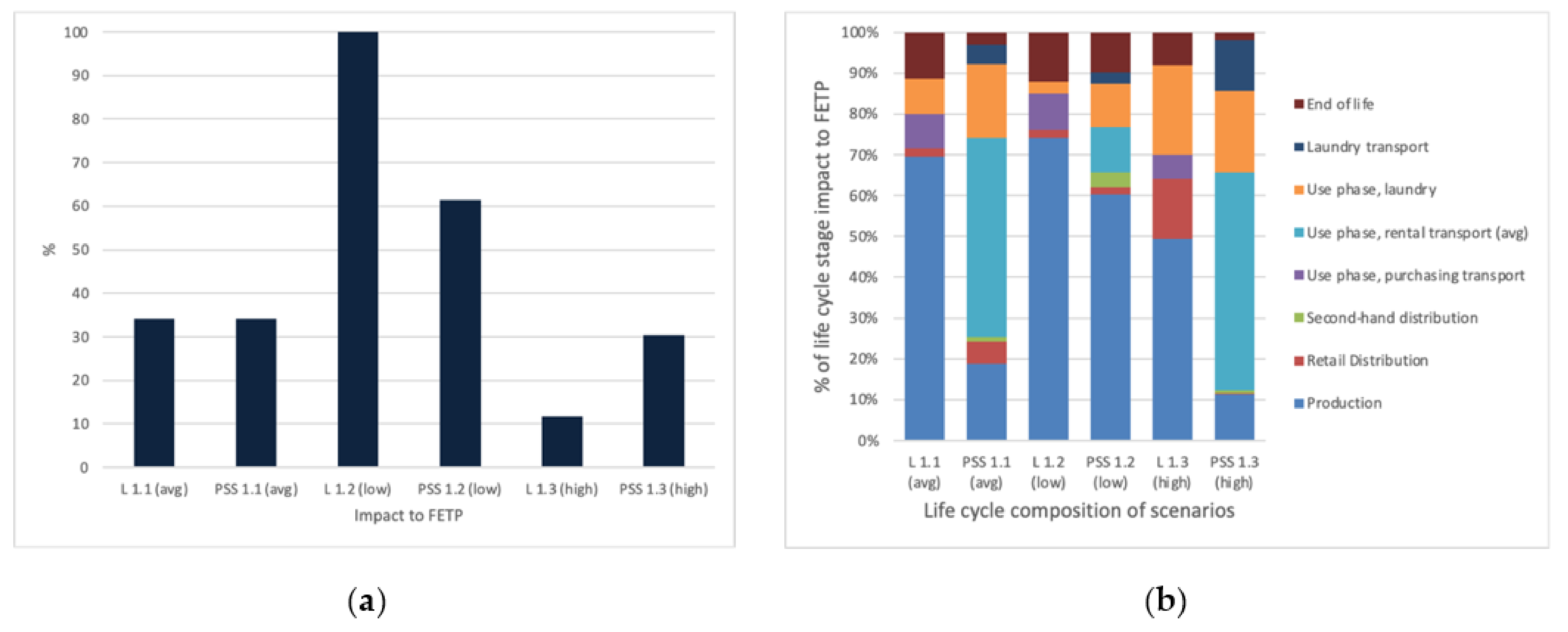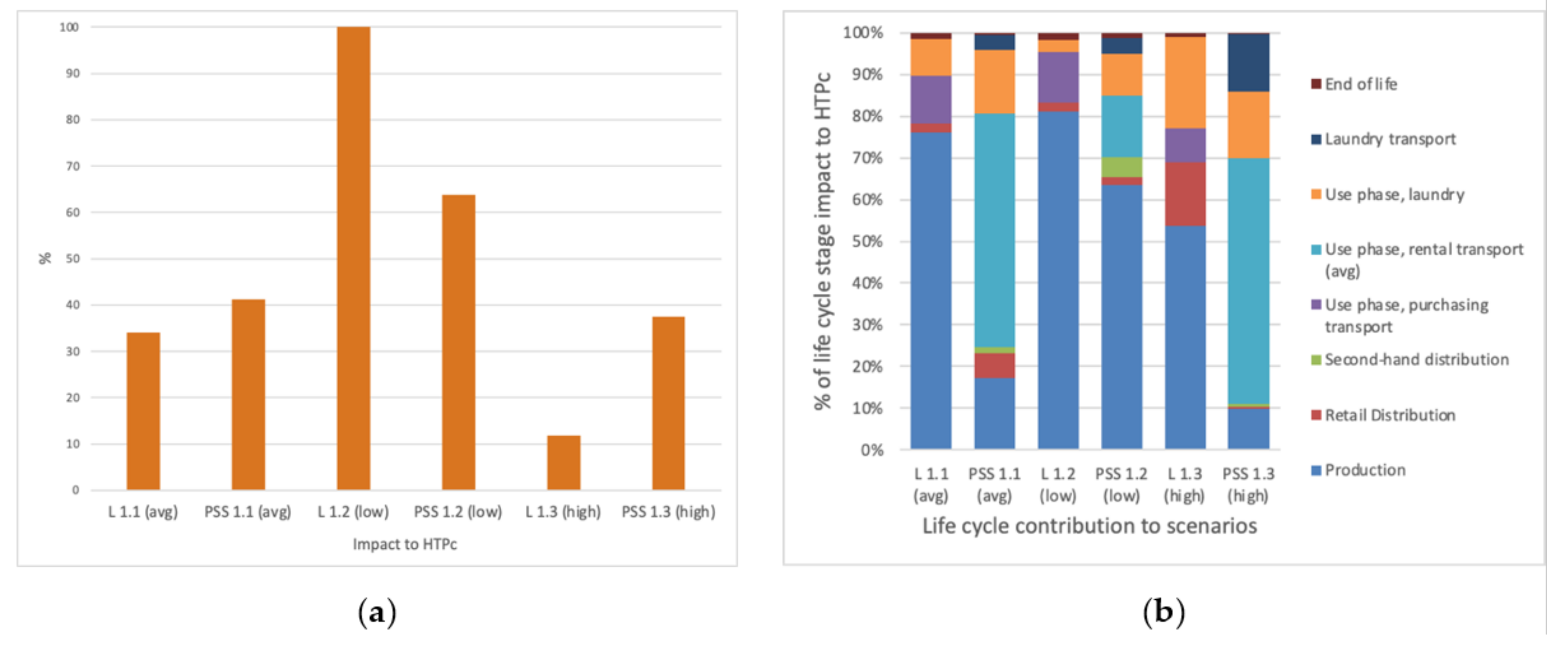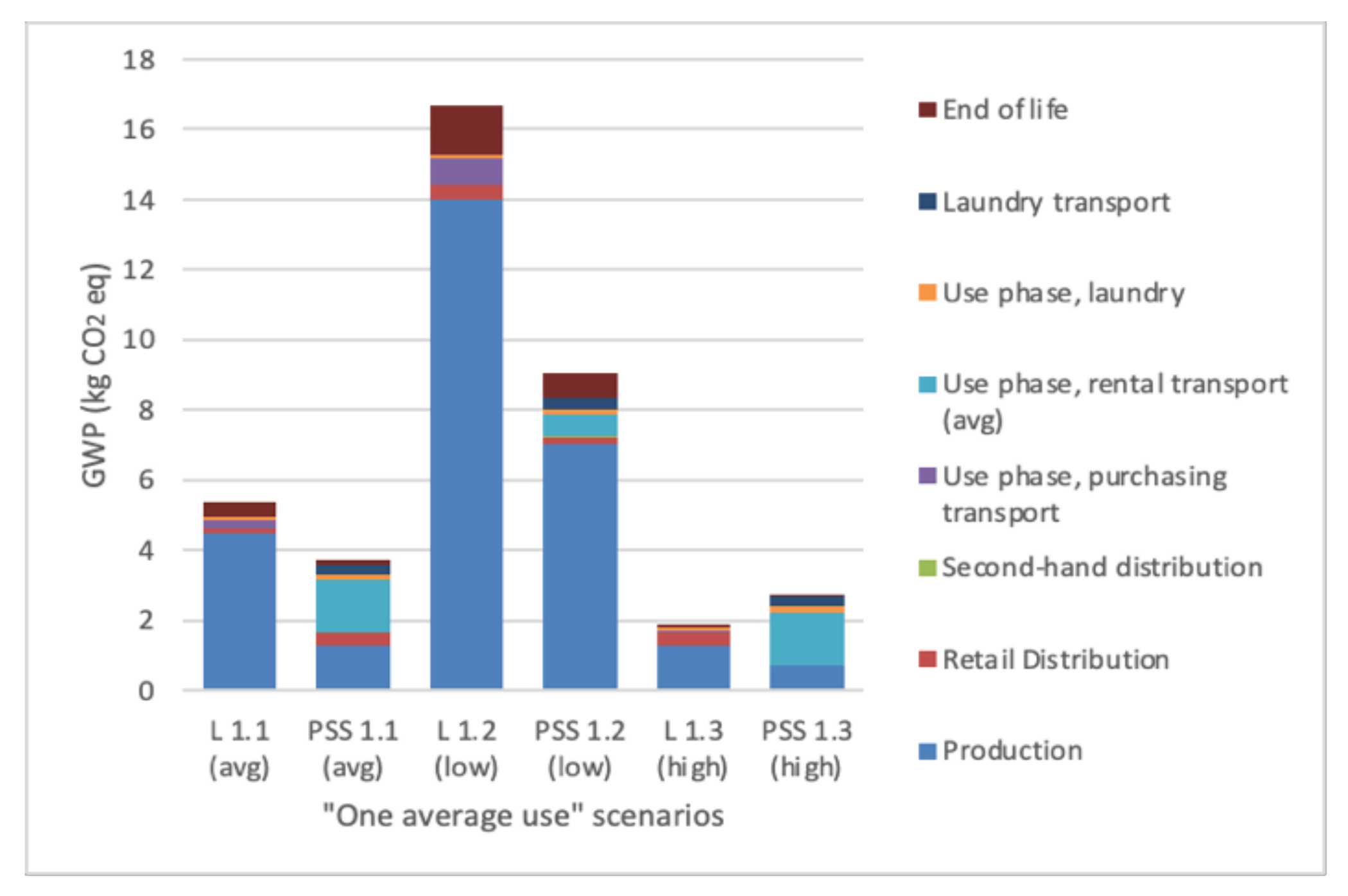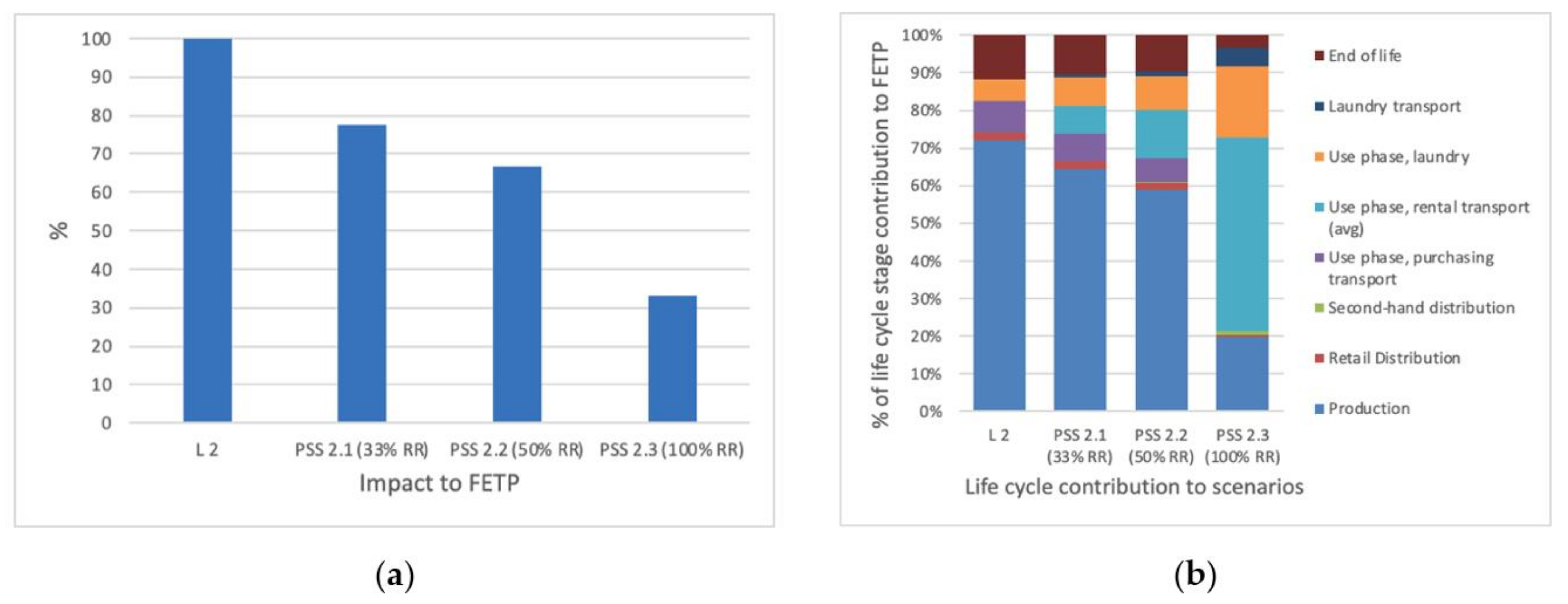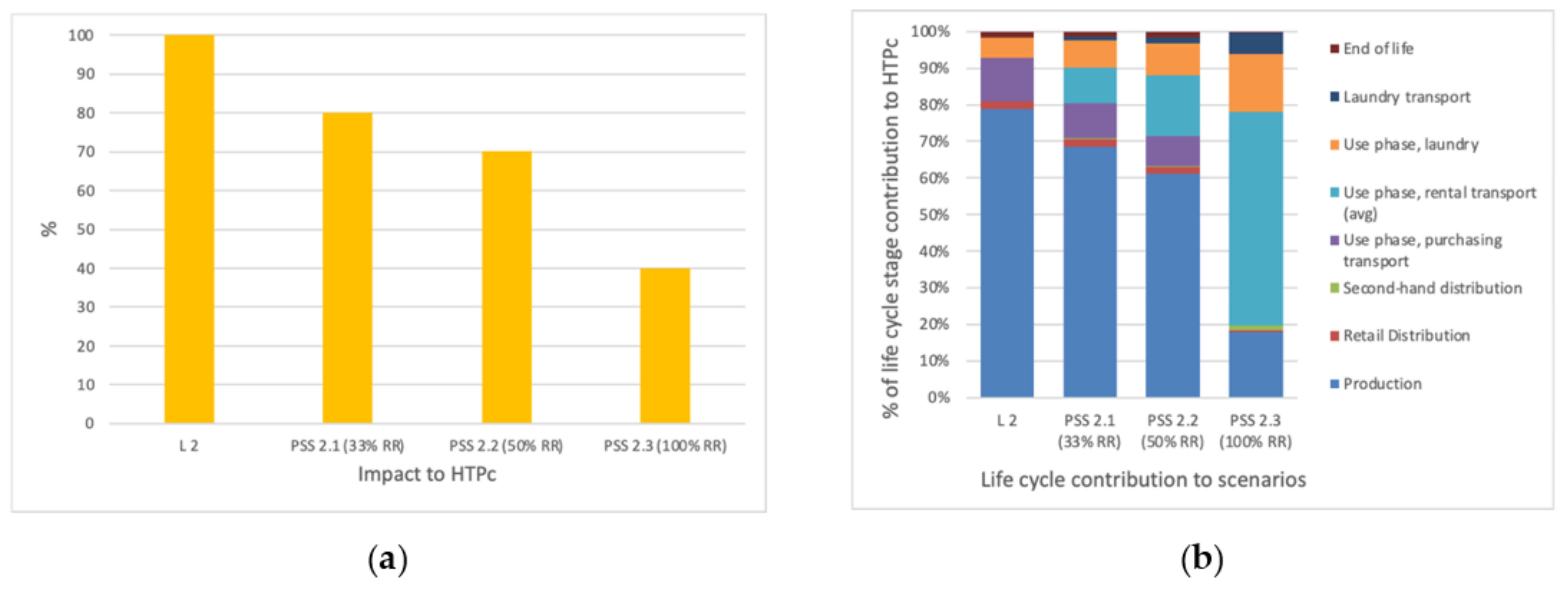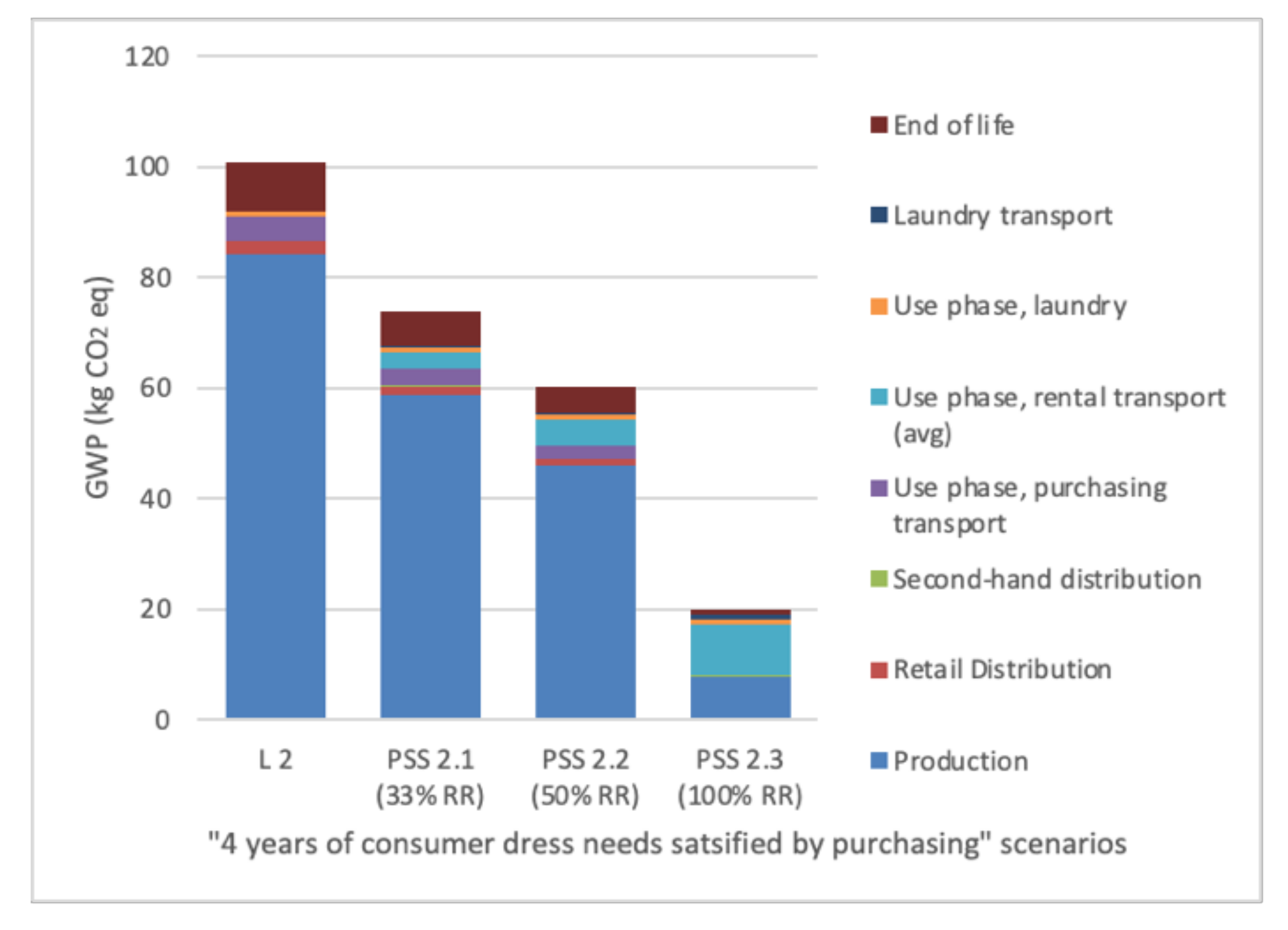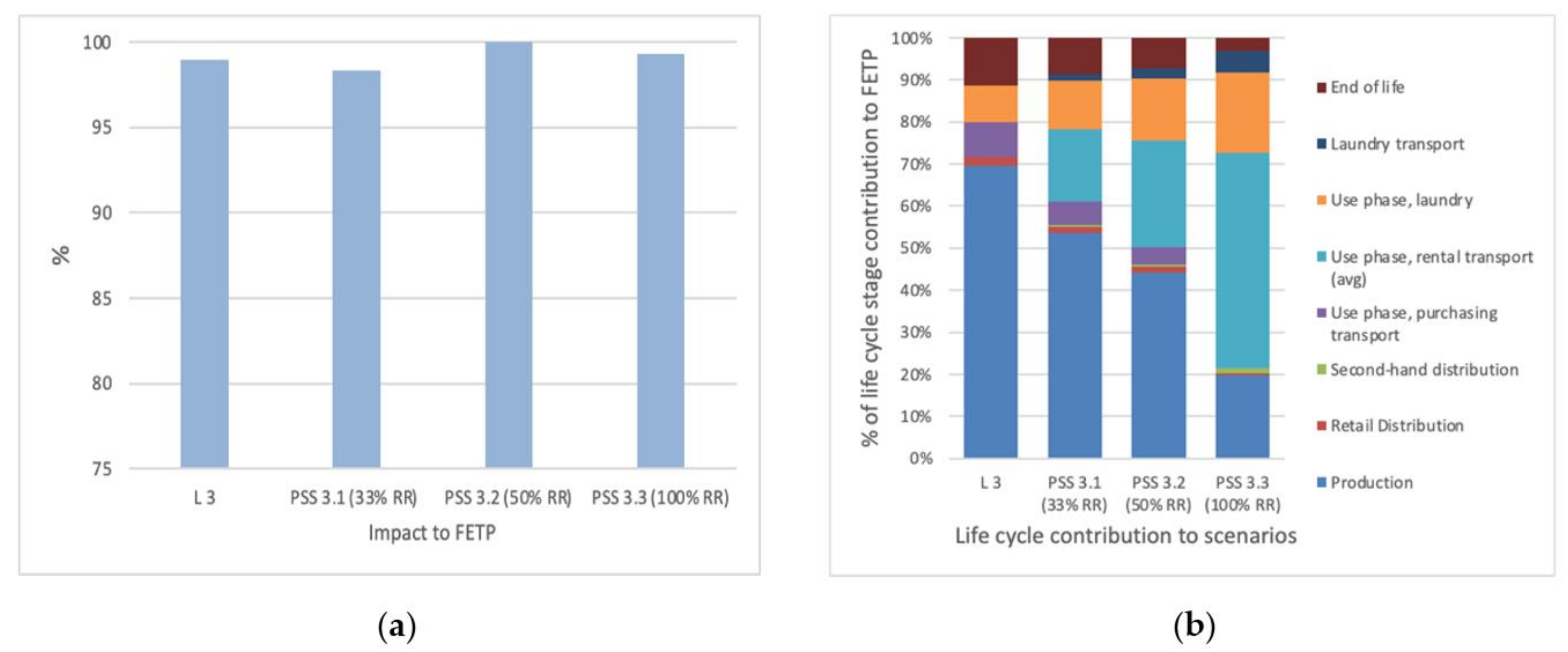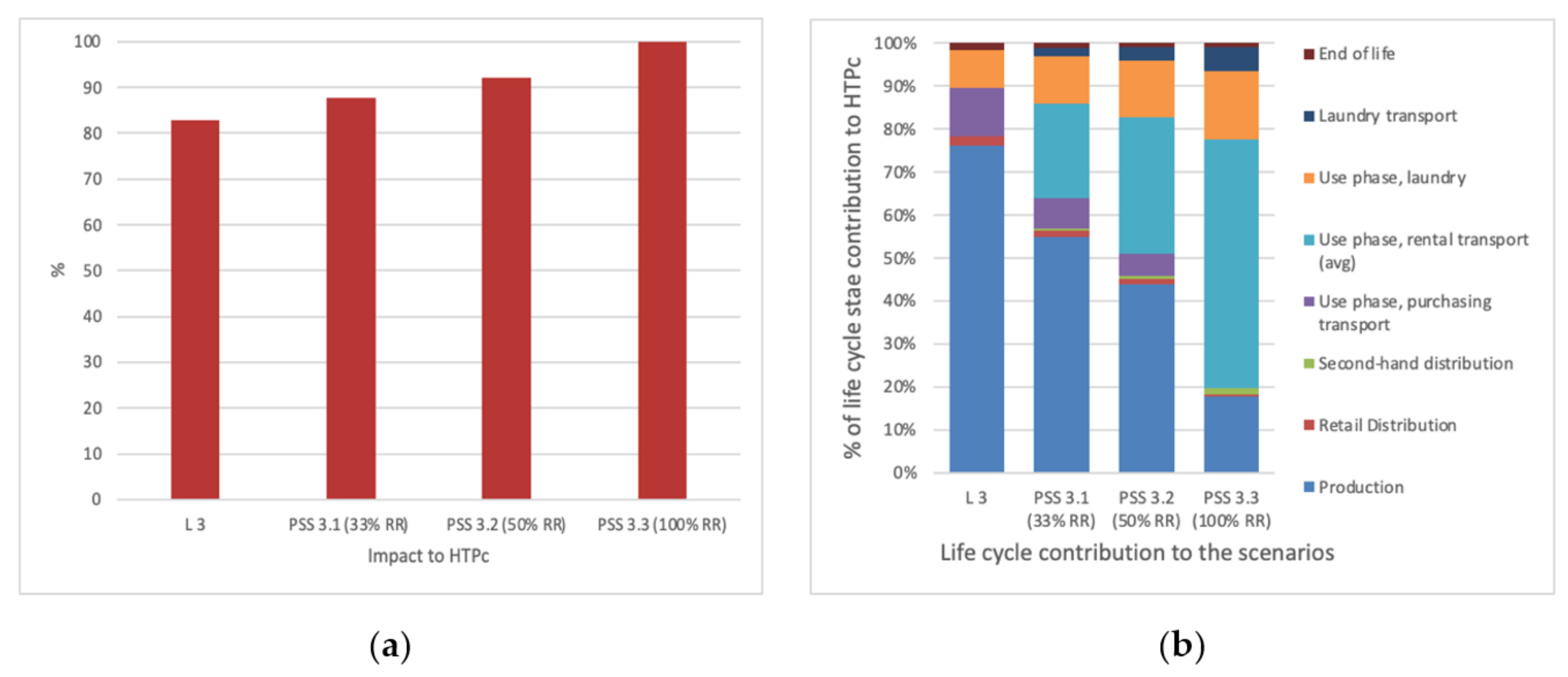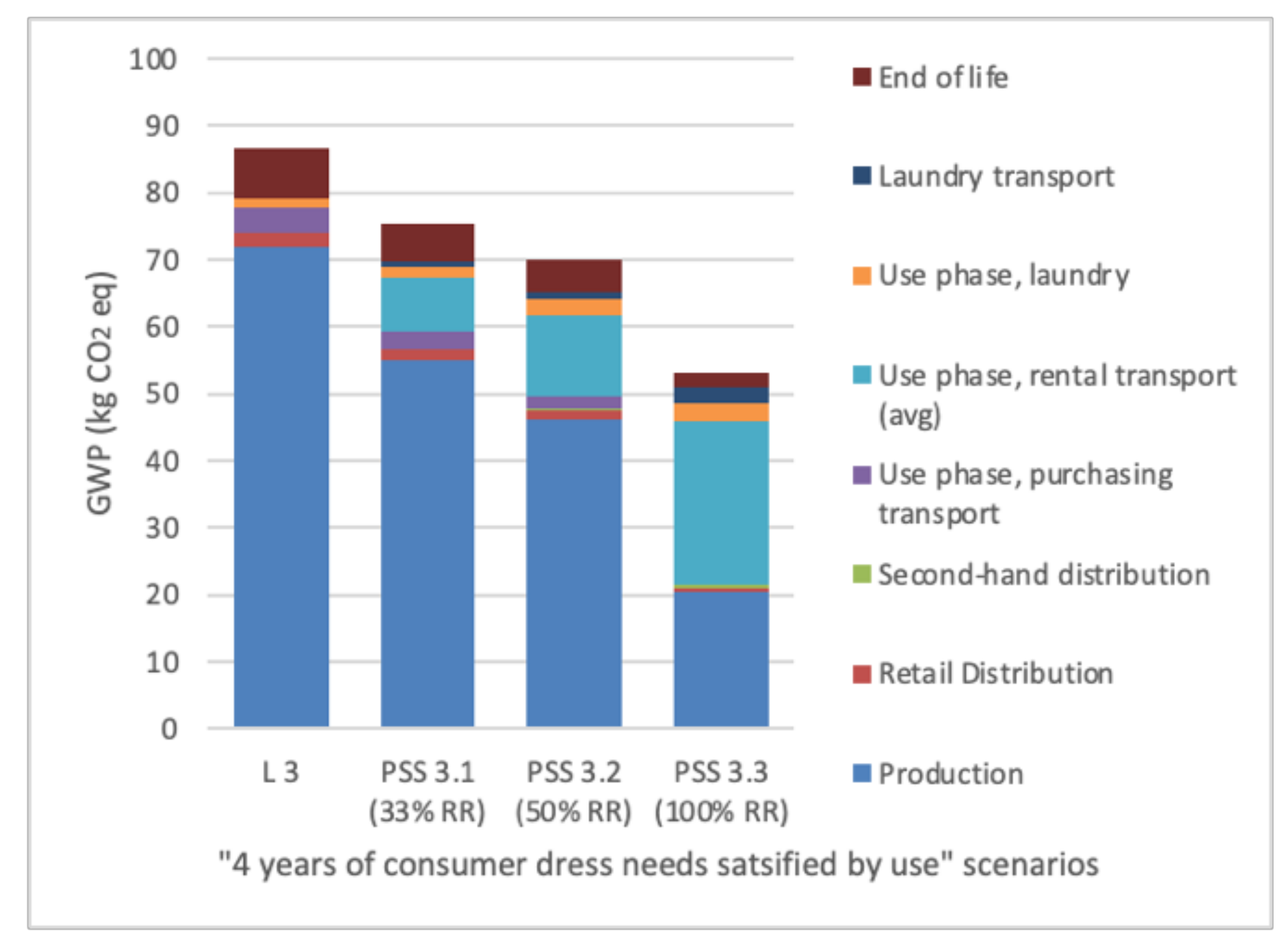1. Introduction
There is an emerging awareness and increasing global effort to reduce current consumption patterns to address resource depletion, climate change, and other environmental impacts. The textile and clothing industry, in particular fast fashion, contributes to resource depletion, produces large amounts of wastewater and solid waste, contributes to chemical and pesticide residues, and is known for the exploitation of workers among many other negative impacts [
1]. Clothing production globally has nearly doubled in the last 15 years, although clothing use intensity has declined by nearly 40% [
2]. Clothes are being consumed at higher rates than the technical lifespans of garments [
3] due to increasing disposable income and the influence of fast fashion in encouraging waste. In Sweden, clothing consumption has increased by 30% since 2000 (roughly 3 kg per person) with the average consumption of textiles per person at 14 kg in 2019 [
4]. Yet Swedes dispose of 7.5 kg per person of textile waste in the residual waste annually, of which over half of that is in a condition for reuse [
5]. In addition to this waste, Swedes send another 4 kg of textiles per person annually to charities or second-hand [
6].
A change to conventional business models (BMs) and consumption habits is needed to reduce current unsustainable impacts [
7]. BMs based on ideologies under the circular economy and the sharing economy are anticipated to contribute to sustainability objectives [
8] and can be seen as solutions in the fashion industry [
9]. Tukker et al. (2015) has analysed and noted BMs like product-service systems (PSSs) often recognise different sustainability goals and are seen as pathways to the acceptance of service-based societies and more sustainable solutions [
10]. Examples of sustainable strategies include circular solutions such as reuse, remanufacturing, or recycling, as well as ideas of moving towards access over ownership [
11]. Providing a product as a service can change consumption patterns and may provide incentives for the optimisation of supply chains and product design to maximise the value offering to the consumer and the company. This could result in extended lifespans of products, higher use intensities, and other value chain optimisations leading to implications such as resource efficiency and dematerialisation.
In the apparel market, 71% of consumers are interested in investing in higher quality clothing and circular business models such as resale, rental, and refurbishment following COVID-19 [
12]. The market for rental services for “one-off occasions and needs” such as for clothing for special occasions, luxury, and sports has increasing potential, particularly with the addition of online rental [
2]. Successful business models for special-occasion wear have already been present for several years, such as Rent the Runway in the US that rented more than 800 million USD in retail value of clothing in 2014 when they exclusively offered special occasion wear [
2]. Prior to the pandemic, the growth for rental business models was projected to increase by 801 million USD between 2019–2023 [
13], and a 2019 survey of 20 of the top retailers indicated that 61% of them wanted to test rental models [
14]. While it is uncertain of the fashion industry’s future after the pandemic, there is increasing interest by consumers to reduce their consumption and engage in more environmentally-conscious practices [
13].
Despite having a sustainability potential, some BMs may not translate to less consumption [
15], and the sustainability outcomes of PSSs are not certain nor clear [
16,
17,
18,
19]. There is a gap between logical claims and empirical evidence of the practical application of sharing and circular economy strategies [
20]. Strategies to extend product longevity for clothing is partly compromised by external factors such as changes in style and fashion obsolescence, which shortens product lifetimes regardless of the material durability [
21,
22,
23]. Furthermore, the environmental benefits of reuse or servicing strategies depend on their ability to displace primary production and minimise the associated impacts [
24]. Although PSSs such as clothing libraries can reduce the speed of fashion if garments are used more times, they also have the potential to promote consumption if users update their closets more frequently [
25]. Some “sharing business models even facilitate consumption, e.g., by offering a service contract which includes regular replacement of a product” [
26] (p. 307). The BM can influence user behaviour, for example, the payment system can affect how many items or how often consumers make a transaction. Each transaction can have an environmental impact, in particular for transportation [
25]. Companies attempting to offer more sustainable products or services must be accompanied by business model innovation, else they will render as merely positive initiatives that suggest sustainability but lack the rigor to replace the dominant linear fashion business models [
27].
However, it is not only the business model nor the product or design that determines the overall sustainability, but consumers’ intentions, behaviours, and habits [
22]. Participating in sharing initiatives such as PSSs may not prevent waste since customers who choose to rent clothes may not abstain from purchasing clothes [
28]. Consumers may choose to rent clothes to increase their wardrobe choices, rather than replace their normal purchasing. Corvellec and Stål (2017) suggest that rental clothing BMs offer consumers a way to avoid the waste responsibility that would usually come with clothing ownership [
28]. The benefit of a PSS offering depends on the extent that production and ownership are substituted by rental, and this extent can be understood as a replacement rate (RR) [
29]. A 1:1 RR of reused goods for purchased goods is unrealistic [
29], and a few studies have found that the overall environmental benefit of textile reuse is highly influenced by the percentage of substitution [
30,
31,
32]. For instance, Farrant et al. [
33] found that in Sweden, the purchase of 100 second-hand garments replaces about 60 new garments. That study found that the collection, processing, and transportation required for the reuse of second-hand clothing had insignificant impacts compared to the environmental savings from avoided primary production; however, this might not be the same for rental since the associated BMs involve multiple users and a need for increased transportation [
22].
Since clothing rental can offer customers classic or unique high-quality fashion items without a commitment to ownership [
23], it is attractive because of reduced fashion costs and positive impacts on disposable income, potentially resulting in rebound effects. Rebound effects can be understood as the environmental consequences of when the environmental impacts of a supposed improvement become less than anticipated due to changes in behaviour such as a direct increase in consumption levels or other substitutional effects among other product/service categories [
34]. The potential for absolute resource decoupling in PSSs only occurs when accounting for the potential rebound effects from changes in user behaviour [
35]. It is difficult to identify and measure how shared clothing can impact the environment since there is no clear information on whether consumers substitute conventional behaviour with sharing, or if it is seen as a complement and further encourages consumption.
1.1. Aim and Scope
This research aims to progress the understanding of the potential environmental sustainability outcomes from PSSs. A business-to-consumer (B2C) use-oriented PSS for clothing is used as a case study to address the following research question: How do user behaviour and business model configuration impact the environmental effects of PSS business models in the clothing rental segment? The research is based on a comparative life-cycle assessment (LCA) of a rental business model (PSS) vs. a linear (ownership) model of dress consumption. LCA is one method that can be used to analyse and quantify the environmental impacts for PSSs along the life-cycle from a system perspective [
22,
35]. The research examines clothing consumption behaviour in relation to business models and quantitatively evaluates the associated environmental impacts. Furthermore, it explores how variations in these behaviours affect the impacts and suggests how changes to consumer behaviour in rental business models can improve the environmental potential of PSSs.
The scope focuses on use-oriented PSS for clothing, meaning rental clothing business models. Shared or rental clothing in this research entails facilitation of use and provision of access. Second-hand clothes are excluded since that indicates ownership rather than access. The case company is specifically on rented pre-owned, formal dresses. The research is analysed with geographical restrictions to Sweden, as transportation infrastructure and energy mixes are specific to Sweden in which these factors may be highly influential in the results. Furthermore, consumer behaviour data collected is specific to customers already engaged in rental with the case company.
While it would be interesting to include all three pillars of sustainability (environmental, social, and economic factors), environmental impacts are the sole focus in this study. The environmental implications of rental are complex to map, and both methods and indicators for environmental assessments are different from those used to assess the economic and social impact dimensions. Methods like life cycle costing (LCC) and social life cycle assessment (SLCA) can be used to analyse the other dimensions of sustainability of PSSs [
36], but LCA is the most discussed method in literature [
37].
1.2. Background: PSSs as Sustainable Business Models
This section summarises the characteristics of PSSs and positions them in relation to the sharing economy and circular economy in order to understand the elements of BMs with the potential to fulfil sustainability objectives.
Research regarding BMs lacks a consensus on a consistent definition, although most definitions share the idea of value creation as a central tenet in the description, as indicated most notably by Zott, Amit, & Massa (2011); Lüdeke-Freund, Gold, & Bocken (2019); Osterwalder & Pigneur (2010), and Teece (2010) [
27,
38,
39,
40,
41]. A BM can be broadly understood as a business’s organisational architecture [
40] that explains how it creates, delivers, and captures values [
39] through its activity systems [
41]. Values and strategies of the circular economy and sharing economy show up in various BM archetypes categorised as sustainable in academia, and archetypes of BMs that facilitate reuse through the provision of services are often based on the literature on PSSs as shown by Bocken, Short, Rana & Evans (2014) [
42]. The concept of PSSs offers BM templates with service-oriented value propositions that enable sustainable outcomes [
43]. Armstrong, Niinnimäki, Lang & Kujala (2016) describe a PSS as a “social archetype of business models for sustainability” [
44] (p. 21), and Mont (2002) states that the benefits of a PSS are characterised by the potential to change consumer behaviour and reduce the need for ownership by introducing alternative access for product use [
45]. Bocken et al. (2014) note that PSSs can incentivise manufacturers to reduce product volume by making longer-lasting products that can be easily repaired [
42].
Tukker (2004) classified PSSs into three categories: product-oriented, use-oriented, and result-oriented [
41]. This study focuses solely on use-oriented PSSs, where a product is still central to the business model offering, but the product stays in ownership with the provider and is made available to several users at different times [
46]. Products are not sold in a use-oriented PSS and can be offered in three forms: product leasing, product renting or sharing, and product pooling [
46] (p. 248–249). An example of how these forms of use-oriented PSSs could show up in the apparel industry are shown in
Figure 1, which have certain implications on how consumers behave and engage with products.
PSSs have been linked with the sharing economy [
26,
48], as well as been cited as a pathway to fulfil circular economy strategies [
34]. However, not all types of PSSs utilise the strategies and goals corresponding to these concepts [
35]. Nevertheless, PSSs can encourage circularity, for example, by selling usage rather than ownership, “and breaking the link between profit and production volumes” [
42,
49] (p. 480). PSSs can facilitate circular strategies through product sharing and extension of service life [
34,
49], as well as promote dematerialization through access-based consumption, increased use intensities of products, and better company control over products’ lifetimes [
44,
46]. These strategies are associated with a ”slow the loop” strategy from circular principles with the aim to extend the service life of the product by reuse, repair, and sometimes remanufacture [
38]. This keeps products at their highest value as long as possible, which is where clothing rental BMs fit in [
38] since the company’s goal is to continue rental of the same garment without changes to the product itself. The objective to slow the loop is also where the sharing economy fits as a concept due to the idea of sharing resources to maximise use [
50] to decrease consumption and prevent the need for more products [
51]. Although the circular and sharing economy can be understood differently, they overlap in their strategy to increase reuse. While some authors perceive the sharing economy as a means to realise the circular economy [
15,
51,
52,
53], Ref. [
54] notes that understanding these concepts in conjunction may help to increase transition to business models with lowered environmental impacts.
3. Results
An overview of the case company’s BM and activities are summarised in this section, followed by the results of the consumer survey which details consumer behaviour and interaction with the case company. The section then discloses the environmental impact results from the LCA.
3.1. A Case Study: Formal Dress Rental in Stockholm
The case company is a B2C clothing library in Stockholm, where customers can rent formal and high-end dresses. Customers pay-per-use for dresses and can choose to rent dresses for 2, 4, 7, or 14 days. Most of the dresses that the company rents are second-hand, in which 60% of the dresses are procured through the company’s own purchasing through second-hand shopping or over-stock. About 40% of the dresses are from clients who rent out their dresses. The company offers an online platform as well as a physical location, and laundry and repair are taken care of by the company. Customers can pick-up dresses from the store or order online. Dresses are offered throughout Sweden, although the current customers live in the Stockholm area, and most choose to pick-up their dresses rather than order online.
The company began business in May 2018, and the data used in the study is from its opening until February 2020. The company has a total of 856 clients and rents an average of 50 dresses per month. The company expected to grow twice as much in 2020 compared to 2019, although this likely changed due to consequences from COVID-19. Clients average 1.09 rentals per user from the time period stated previously. The company offers 317 active dresses that are rented and owned by the company and 163 actively rented dresses that belong to clients. Due to the large dress assortment and the company’s relatively new market presence, it was estimated that the average number of times a garment is currently rented is two times. However, some dresses have been rented many more times, with the top three dress rentals having been rented 17 times, 15 times, and 12 times. The company estimates that based on the top-rented garments’ quality and wear, they could be worn between 5–15 more times.
Rental Clothing and Consumption Behaviour
The section summarises the main findings from the consumer survey and provides insight on consumer purchasing frequency, use intensity, and laundry frequency in a linear BM. It also summarises consumer transport behaviour and patterns for the linear and PSS BM, along with consumer rental motivation and substitution of rental for purchased dresses. Lastly, it discusses responses to hypothetical changes to the rental BM and categorises consumer consumption types.
The purchasing frequency of formal dresses by the case company’s users was calculated as a weighted average of 1.5 formal dresses purchased annually. Most respondents wear their purchases of formal dresses 3 times or less (68%), with just 4% stating that they wear one formal dress more than 10 times. A weighted average was calculated for consumers to wear formal dresses an average of 3.12 times. The majority of respondents (63%) stated they only wash their dresses when it appears dirty, with 26% of respondents washing after every use and 11% after every other use.
Consumers were asked about their primary and secondary transport modes in how they travel to the store to purchase items and how they travel to the case company to rent. Consumers answered very similarly for both cases, with the metro (tunnelbana) as the most popular form of transport as the primary mode (47% of respondents traveling to shop, and 54% of respondents traveling to the rent). The bus is the most popular secondary form of transport (48% of respondents traveling to shop and 32% of respondents traveling to rent). Four transport scenarios were created as the most common forms of primary and secondary transport: metro and bus (average), metro and walking, biking and metro, car and metro. Consumers were also asked how they planned their trip to the case company rental store, in which 55% of respondents stated they combine the visit to the rental store location with other errands, and 45% stated they make a point to just go to the rental store.
When customers were asked how renting dresses from the case company affects their normal shopping behaviour, respondents selected a number on a scale from 0–10, with 0 representing no impact, to 10 as 100% substitution of rental dresses for purchased dresses. Substitution refers to the RR. A majority of the respondents indicated that they considered their participation in renting dresses as a substitution for buying dresses, with a weighted average of respondents’ reported RR as 70%. Fifty-three percent of respondents stated that they still purchase dresses even though they rent. When respondents were asked an open question inquiring the reasons why they felt they still needed to buy formal dresses, the following reasons were the most common: the limited number of dresses available to rent, if consumers wanted to wear a dress many times, and if dresses were well-priced to purchase. Many respondents commented that they purchase dresses because of a need to have casual or everyday dresses that would be worn more often, indicating that the rental company fulfils a very specific niche of clothing for formal and special events.
The primary motivator to rent for most respondents was to “avoid having to purchase a dress” (35% of respondents), followed by “environmental concerns” (21%). The most common secondary motivator to engage in rental was to “wear unique dresses” (33%), and the lowest motivator for the majority of respondents (72%) was having “influence from friends to rent”. When asked if they would want to rent more dresses if the case company would offer a membership fee rather than pay-per-use for their dresses, 70% of respondents stated that they would not. Of respondents who did indicate their interest in unlimited rentals, 88% of them said they would rent dresses as needed, not at the same time. This would be impactful for the specific BM of the case company, as renting dresses as needed implies an increase in consumer transport.
Respondents were asked to identify a consumer shopping profile that they felt described their behaviour best (
Table 1). Respondents identified the most with the “stand-out” profile (51%). When consumer profiles were assessed individually, there was some variation in the respondent’s garment usage, purchases, and stated RR of rental dresses over purchased. The use intensity and the number of purchased dresses did not vary greatly, but the RR varied quite a bit (
Table 1), with the lowest stated RR as 46.70% for influencer consumer profiles and 90% RR for eco-friendly consumer profiles. The consumer profiles did not have any patterns in terms of demographic characteristics even though age, education level, and annual income were collected. The consumer profiles suggest that rental clothing companies are most attractive to consumers desiring to have unique clothing, followed by those motivated to save money. However, rental clothing appears to be more successful in replacing ownership for consumer types that identify with eco-friendly shopping as well as the desire to fit-in in terms of their style.
3.2. Environmental Impact by Functional Unit
Three functional units are presented since different motivations to rent implies that consumption satisfied different needs. The FU “one average use” is presented first, and is considered a narrow definition of the FU that provides a somewhat simplistic but more concrete understanding of the impact associated with one use of a dress in a linear vs. a rental scenario. This involves dividing certain activities in the LCI such as dress production, by the total number of uses or users in the scenario. Although it factors in variations in the use intensity of a garment, the scope of the FU is limited since it does not consider how rental clothing can displace production for purchased clothing.
The other two FUs are more broadly defined, in which “4 years of consumer needs” for a formal dress are analysed. As some respondents from the survey stated their primary motivation to rent was to “wear unique dresses” or “to access different styles”, then the FU “user dress needs for 4 years satisfied by purchasing” was analysed. Other respondents who appear to have more satisfaction with the number of times a garment can be worn, such as consumers who stated their primary motivation to rent was to “avoid having to buy a dress”, or “to save money”, or “for environmental concerns” is addressed by the FU “user dress needs for 4 years satisfied by the number of uses or wear occasions”. These FUs include a RR where rental dresses replace linear dresses to some degree either by the garment itself or by the wear occasion. These more broadly defined FUs take a systems-thinking approach by considering rental systems’ potential to displace linear consumption systems on a specific product-basis. Although these FUs include more effects from consumer behaviour, more assumptions have to be made which introduces more uncertainty. A description of the scenarios analysed for each FU can be found in
Table 2.
The most significant impact categories out of the 18 midpoint indicator categories for all three FUs were freshwater ecotoxicity (FETP) and human carcinogenic toxicity (HTPc). The results for FETP and HTPc, as well as global warming potential (GWP) are analysed amongst the scenarios.
3.2.1. Impact of One Average Use
The scenarios for the FU “one average use” shows how differences in the total number of users for a garment change the impact of one average use in a PSS, and the total number of uses of a garment in a linear system. The total number of uses is important since the increase in overall usage decreases the share of the environmental burden from the production stages, as well the transoceanic shipment for retail distribution, and the consumer’s trip to the store to purchase an item. The increased usage however, does not impact the transport for rental, since 2 trips are still needed for every rental (pick-up and drop-off of the item).
The PSS scenario with the greatest number of users (PSS 1.3) (see
Figure 3a) has the lowest impact contribution to freshwater ecotoxicity potential than the other PSS scenarios. However, the linear scenario with the greatest number of uses (L 1.3) contributes the lowest impact to this category overall, 20% less than the high-user PSS scenario (PSS 1.3). Although PSS 1.3 reduces the percentage of the impact from production by increasing the total number of users/rentals (
Figure 3b), the high amount of transportation required for rental results in a higher impact contribution in this category than the high-use linear scenario. The low-use linear scenario (L 1.2) has the highest impact in this category, resulting from the high impacts of production (
Figure 3b). Although the lowest PSS user scenario (PSS 1.2) has a very low amount of total uses, its impact in this category is 40% lower in this category than L 1.2 despite increased transportation needs. The average use scenarios for the linear system (L 1.1) and PSS system (PSS 1.1) have relatively the same overall contribution to the category, but the impact from L 1.1 comes primarily from production (70%) and the impact from PSS 1.1 comes primarily from consumer rental transport (50%) (
Figure 3b). This indicates that the scenarios with the lower impact potential for freshwater ecotoxicity are when purchased dresses are used many times by garment owners themselves, followed by a high number of users to rent the same garment.
When alternative transport modes are included, all PSS scenarios with the high-impact transport combination become the highest contributors, above the linear scenarios (see
Figure A1). L 1.3 remains the scenario with the lowest impact, followed by PSS 1.3 with one of the public transport combination modes. This means that increased use by garment owners remains the least impactful for freshwater ecotoxicity, followed by high user rental when using public transportation. The benefit for PSS changes when using high-impact transportation, as PSS 1.3 with car transport has a 75% higher impact in this category than PSS 1.3 with average transportation. All PSS scenarios excluding car transport scenarios have a lower impact than the low-use linear scenario (L 1.2), indicating that all rental scenarios have a lower impact than low usage for a dress owner if public transportation is used (see
Figure A1).
The human carcinogenic toxicity potential was highest in L 1.2, followed by PSS 1.2, (see
Figure 4a), in which 81% and 63% of the impact are contributed from production (
Figure 4b). This is followed by PSS 1.1 (with 17% impact contribution from production and 56% impact contribution from rental transport), then PSS 1.3 with 59% impact contribution from rental transportation. This indicates that rental transport is responsible for a large share of impact contribution to this category, meaning that increased use of a garment such as in PSS 1.3, can increase the impact for human carcinogenic toxicity if increased use is associated with more transport. This is shown as L 1.1, where a purchased garment worn with an average of 3.12 uses (76% of impact contribution from production), has a lower impact than the rental scenario with increased users/rentals (PSS 1.1, 1.2, and 1.3).
The variation for transport scenarios for HTPc shows that the PSS scenarios with car transport have the highest impact, followed by the low-use linear scenario (L 1.2), then the low-use PSS scenarios (PSS 1.2 with the public transport modes), as shown in
Figure A1. If the scenarios with the high-impact transportation mode are excluded, production accounts for a higher impact in this category, as it contributes to 81% of the impact in L 1.2, and 64% of the impact in PSS 1.2 (
Figure A1). L 1.3 has the lowest impact, followed by PSS 1.3 with nearly the same percentage contribution as L 1.1. This indicates again that increased usage for purchased garments has potentially the lowest or nearly the same impact as high usage in a rental scenario when consumers use public transportation modes. Although high usage in rental scenarios greatly decreases the share of impacts resulting from production (
Figure 4b), the increased share of rental transportation in these scenarios contributes a greater impact than increased owner usage.
While
Figure 5 indicates that one average use in a PSS BM has a lower carbon footprint than the linear BM with average and low use (PSS 1.1 has a lower GWP than L 1.1, and PSS 1.2 is lower than L 1.2), PSS 1.2 has a higher carbon footprint than L 1.1, indicating that increased use of owned garments in a linear scenario has a lower carbon footprint than renting clothes if garments are not rented or used enough times. Furthermore, PSS 1.3 with a high amount of users has a higher GWP than L 1.3 with high-use because of the large amount of use-phase transport in the PSS models. The impact contribution from transport increases with increased users and rental while the share of the production impact decreases in the PSS scenarios, and the increased use in purchased garments results in a reduced carbon footprint as the share of production impact decreases. This indicates that the use intensification of garments already in ownership can offer greater savings in an individual’s carbon footprint than engaging in rental clothing when rental requires a high amount of transport per rental transaction. Different combinations of transport modes show that the linear scenario with the highest number of uses (L 1.3) has the lowest carbon footprint, followed by the high-use PSS scenarios with public transport scenarios (see
Figure A2). However, the average and high-use PSS scenarios with car transport are both higher than the average and high-use linear scenarios. This is noteworthy, as when comparing linear to rental scenarios, rental business models should be in good proximity to consumers to encourage walking/biking and use of public transport, and to reduce overall impact from transport. Furthermore, rental BMs should be in locations that do not incentivize driving.
3.2.2. Consumer Dress Satisfaction by Purchasing
The scenarios for the FU “4 years of consumer formal dress needs satisfied by purchasing” show how differences in the RR of rental for purchased dresses change the impact of consumption. Since rental clothing was not found to substitute ownership of dresses completely, the PSS system also includes some purchased clothing.
The linear scenario (L 2) has the highest impact contribution to freshwater ecotoxicity potential (see
Figure 6a). With an increase in the RR, the impact in the PSS scenarios decreases, which can be attributed to the decreased need for production. This is shown where the percentage share of production in the overall impact to the category decreases from L 2 to PSS 2.3, meaning that the impact of transportation is less significant than production in this category (
Figure 6b). The impact for PSS 2.3 with the 100% RR is 67% less of the environmental impact of L 2 for freshwater ecotoxicity, indicating the potential for full substitution for purchased dresses, as PSS 2.2 is 44% less, and PSS 2.1 is 33% less than the impact for the linear scenario. Adjusted transportation scenarios (see
Figure A3) with high-impact transportation show that the benefit of a high RR in PSS 2.3 is negated and has a much larger impact on freshwater ecotoxicity, even more so than the linear scenario. The linear scenario (L 2) has around 60% less impact than the PSS scenarios with the high-impact transport modes. However, the PSS scenarios with public transport modes all have lower impacts than the linear scenario.
The contribution for human carcinogenic toxicity shows that the linear scenario (L 2) contributes the most impact to this category compared to the rental scenarios (see
Figure 7a). This is followed by the PSS scenarios with the lowest RR. The impact from PSS 2.1 with a 33% RR has 20% less impact for human carcinogenic toxicity than L 2, with PSS 2.2 with the 50% RR having 30% less, and PSS 2.3 with 100% RR for purchased clothing with 60% less impact in this category than the linear scenario. The decrease in impact to this category is associated with the decrease in the overall share of production impacts, as shown in
Figure 7b. In the adjusted transport scenarios for the human carcinogenic toxicity category, the PSS scenarios with the highest RR and high-impact transport become the highest impact contributors over L 2 (see
Figure A3). PSS 2.1 has a 7% higher impact, PSS 2.2 with 11% higher impact, and PSS 2.3 with 21% higher impact when modelling with car transport. All other transport scenarios for the PSS scenarios have a lower impact than the linear scenario.
Figure 8 shows a decrease in global warming potential with an increase in the RR, indicating that individual carbon savings can be 80% less if rental clothing substitutes 100% of the need to purchase. If rental clothing substitutes just half of purchasing needs, there are 40% savings, and if rental substitutes 33%, there are 27% savings in kg CO
2 eq per person. When testing alternative transport modes, as shown in
Figure A4, all PSS scenarios have less impact on GWP than the linear scenario (L2) even when including the high-impact transport modes. PSS 2.3 with the 100% RR and high-impact transport mode has 5% less impact contribution to GWP than PSS 2.1 with average transport and 33% RR. It however has a 10% higher impact than PSS 2.2 with the 50% RR and average transport. This indicates that the use of high-impact transportation modes can have less impact if it is associated with a high RR for purchased garments in comparison to low RR, but there is a threshold where the impacts from transport overtake the impacts from decreased production, as shown with the PSS 2.2 scenario.
3.2.3. Consumer Dress Satisfaction by Use
The scenarios for the FU “4 years of consumer formal dress needs satisfied by use” show how differences in the RR of rental for purchased dress wear occasions change the impact of consumption. Similar scenarios are set up as in the previous section, however, the RR is now applied to the number of uses, or wear occasions not the number of garments purchased.
The impact on freshwater ecotoxicity potential has very little difference between the scenarios. PSS 3.1 with the 33% RR for the number of wear occasions for rental over purchased has the lowest impact. PSS 3.2 with the 50% RR has a 2% higher impact than PSS 3.1 and the linear scenario (L 3) (
Figure 9a). PSS 3.2 also has a 1% higher impact than PSS 3.3 with the 100% RR. This indicates that if consumers are using rental dresses to replace one use or wear occasion for clothing, then an increase in the number of uses from rental is not beneficial with increased transport and with the need to purchase dresses. This is shown in PSS 3.2 with a 50% RR, where an increase in the number of rental dresses used just once with combined purchasing has a higher impact. PSS 3.3 with a 100% RR has a slightly lower impact than PSS 3.2, indicating the potential benefit of just rental. Variations in the transport mode for freshwater ecotoxicity have relatively the same impact across all scenarios from the linear scenario to all PSS scenarios, excluding the PSS scenarios with the high-impact transport scenarios. PSS scenarios using car transport have between 3–10 times more percentage than the other scenarios, as shown in
Figure A5.
PSS 3.3 has the highest amount of impact contribution to human carcinogenic toxicity, with the linear scenario as the lowest (L3), with 18% less impact (see
Figure 10a). The impact increases with the increase in the replacement rate for use, which indicates that high transport associated with increased RR for rental contributes the most to human carcinogenic ecotoxicity potential, as shown in (
Figure 10b). When testing different transport scenarios, there is no significant variation in the results, except for the high-impact transport scenarios (see
Figure A5).
The impacts on GWP decrease with the increased replacement of wear occasions by rental dresses, as a result of the decrease of production contribution (see
Figure 11). Since transportation in the rental company is a large portion of the activity associated with rental due to the need for logistics and reverse logistics,
Figure A6 indicates that that the renting of clothing can have a higher impact on GWP than purchasing if consumers use high-impact transport modes. Since the results are associated with RR for use, it is logical that the scenarios with higher RRs have a larger impact with the transport scenarios involving cars since more travel is associated with each use. It should be noted that this differs from
Figure 8 and
Figure A4, as the RR for that functional unit is associated with the rental replacement of purchased garments.
4. Discussion
The following section summarises the impact of user behaviour in PSSs on the LCA results and the implications of the results for more sustainable consumer action and business models. It then discusses the importance of the selected impact categories as well as data and research limitations.
4.1. User Behaviour Variation and Impact on LCA Results
The environmental savings potential that a PSS can have is influenced heavily by how consumers choose to engage with rental BMs. This is shown in how many times consumers use garments, how they use rental to substitute or complement their purchasing or use needs, and how they choose to travel to rental store locations.
Consumers’ use intensity of garments is important both in the linear and PSS BM. Increased use intensity of clothes they already own or have purchased can significantly decrease the environmental impacts of production. Consumers can also increase their use intensity of garments in the same rental period to reduce their impact from transportation, as well as engage in more rentals if they use low-impact transportation modes.
The RR of rental for purchased dresses plays an important role in discerning the environmental benefit of rental clothing. Users who rent solely in addition to normal purchasing are not creating any benefit, however, as their engagement with rental reduces the need to purchase and produce products, the benefit of rental increases.
Variation in transport modes was only modelled for consumer transport to the rental store, and results between the high-impact transport and other transport modes were significant. Users who choose to take public transportation modes, such as the metro and bus combination, metro and walking, and cycling and metro scenarios can significantly reduce their impact and increase the environmental potential for clothing rental. Consumers who use high-impact transport such as cars, negate the benefit that a PSS could have and result in a higher impact than linear scenarios.
A summary of the highest and lowest contributing scenarios is summarised in
Table 3. While the first two functional units are consistent across impact categories in the highest and lowest contributing scenarios, the last functional unit’s scenarios varied in the contribution for each impact category. However, in interpreting the impacts for the three analysed FUs, the benefits of PSS are more apparent when considering the change in effect that renting dresses can have on consumption and the impact of production. This is shown in the “four-year” scoped FUs, while the “one average use” FU shows a limited perspective and benefit that a PSS may have.
4.2. Consumer Behaviour and Business Model Implications
This case study analysed a niche company offering rental formal dresses, a concept that is not new since rental formalwear has been around for several years, notably with the company, Rent the Runway in the US. Although this case study focuses on a specific product, the results are illustrative to interpret and map the environmental potential for other types of garments or products, as well as understand the type of infrastructure needed to support low-impact transport of products in PSSs.
The general low-use intensity and need for special-occasion wear suggest the potential to lower production impacts by increasing the overall usage of these types of garments. Although a decrease in garment production is beneficial, the associated transport needed to facilitate one garment rental creates a high impact that could reduce the PSS’s potential for environmental impact savings. PSSs must encourage increased use not only through multiple rentals, but also for one user to wear the same garment many times during the rental period. This could perhaps be facilitated by longer rentals, e.g., a few months rather than a few days or a week. However, this type of rental scenario will likely not work for special-occasion wear, such as in the case company. If consumers are looking for unique garments for certain events, it renders the reuse of a garment as impractical by the same renter. However, longer rental time frames would be an important attribute for casual rental wear companies to have. Casual renting clothing could include anything from jeans to jackets, to more everyday clothing such as shirts. Longer rental time frames can also apply to PSSs offering other products where ownership can be wasteful and inconvenient, but where users may need a certain product for a slightly longer term, such as rental furniture to students.
Special-occasion wear rental companies can focus on securing locations that are central and require little or low-impact transportation, or find low-impact delivery services to facilitate forward and reverse logistics. For example, bike-delivery in cities with supportive cycling infrastructure. In locations with low public transportation services and longer distances, such as in the US where cars are often necessary, PSSs may not be the most environmental option if consumers must facilitate the pick-up and drop-off. However, PSSs in more remote locations could use more mainstream delivery methods to consumer homes, or set up distribution and redistribution networks. This for example could involve collaborations with small stores for multiple pick-up and drop-off locations, such as done with Wardrobe, a rental clothing company in New York that collaborates with local laundromats as part of its pick-up and drop-off network.
Although the different FUs imply slightly different suggestions for the best alternative actions for consumer behaviour and business model structure, general takeaways for consumer behaviour and clothing rental business models are suggested from the results to offer more sustainable options for clothing consumption.
Consumer behaviour implications:
Consumers should purchase garments only if they will keep and wear them many times. They should avoid purchasing clothing items that they would only wear a few times;
If consumers rent a garment, they should wear it multiple times during that rental period;
Consumers who rent clothing should use rental to fully replace their purchasing needs and avoid partial substitution;
Consumers should completely avoid driving to rental locations and combine trips to the rental store with other travel plans.
Business model implications:
Traditional retail BMs should create garments that last long in terms of style durability. Then material and technical durability should follow to support customers’ increased usage;
Rental BMs should increase the use of garments per rental period by offering longer rental periods and disincentivising one-use rentals. For example, pay-per-use schemes should be avoided;
Rental BMs should offer a large enough inventory to provide enough variety and selection for consumers to use rental as a full replacement for purchasing;
Rental companies should reduce transport needs within their company, for example, with laundry;
Rental companies should have pick-up and drop-off locations in shorter distances to consumers’ homes.
4.3. Choice and Relevance of LCA Impact Categories
Three impact categories were included in this study: two categories that were shown as most significant (FETP and HTPc), and GWP which was analysed in addition. Although these impact categories are perceived as relevant when consulting previous LCAs for garments, assessing all the impact categories would provide a more holistic overview of the impact of both systems. Impact categories or indicators often reported in industrial assessment appear to not be the most significant impacts, as suggested by this study. For example, the company Reformation uses RefScale, an LCA tool to calculate the CO
2, water use, and waste footprints of their garments [
78]. The Higg Material Sustainability Index (Higg MSI), created by the Sustainable Apparel Coalition and used commonly in the apparel industry assesses four impact categories: global warming, eutrophication, water scarcity, and abiotic resource depletion/fossil fuels [
77]. This study analysed the commonly reported impact category of GWP, which showed positive results for the rental scenarios. However, results were slightly more mixed with the significant categories, which are not typically assessed in the industry. Industries must assess the broad impacts of production throughout various impact categories and justify the assessment of their chosen impact categories when creating products.
4.4. Data Limitations and Assumptions
The scope of the study was specifically on formal dress consumption. This does not, for example, account for how dress purchasing or rental could incentivise other purchases, e.g., the potential indirect rebound effects of consumption. For example, the ability for consumers to wear dresses for cheaper through rental could incentivise them to buy other accessories, such as shoes that they previously could not afford, or buy more of something else. This is not accounted for in the LCA study, as it would require a more comprehensive behaviour study and would better be suited to consider in a consequential LCA approach or other modelling methods, such as an environmentally-extended input-output assessment or other econometric tools. Data gaps are always present in LCIs [
64], but this research utilised data triangulation to select the most relevant and reliable data for the case study. However, it is important to discuss how the data selection and assumptions made affect the overall results.
Production data was based on secondary data provided by literature, and the material modelled (polyester) was consistent with the common material composition for dresses in the case company. The various impacts from different materials and fibres are not tested in this study, although the material used could affect the overall durability of garments, the number of washes required, and the potential for garments to be upcycled and/or recycled. The material of garments also affects the upstream processes of extraction of resources to produce fibres. Modelling of a cotton dress instead of polyester could perhaps have had a larger water footprint, although this was not analysed.
Consumer behaviour data was based on the survey, which reflects a very specific respondent group. Although the data was compared to literature, data was primarily used from the survey since the information was highly specific to formal dresses, while the literature generalised garments and all dresses. The consumer purchasing frequency was calculated based on consumer responses from the survey. The purchasing frequency likely differs in different cities, as well as countries, where the number of dresses purchased could change based on the affordability of dresses in the region, the strength of the second-hand market, and the community atmosphere (if dresses are shared informally between family or friends). The change in purchasing frequency could then alter the environmental consequences of both systems under analysis. The average use intensity of purchased formal dresses in the survey was much lower than that found in literature, although this is attributed to the specific types of dresses that are rented in the case study, in comparison to generalised garments analysed in the literature.
The laundry frequency was estimated based on the weighted average of consumer responses and the average number of uses from the survey, and may be slightly higher or lower for consumers perhaps than actual behaviour. A wash cycle was assumed to be a small load of 1 kg, in which the impact of one wash cycle is attributed to one dress, although dresses are half the load size. Since a dress must be washed no matter if there are other items to be washed with it, the burden was allocated to the dress. A wash cycle was also assumed to be filled with water to the average load of 3.4 kg, despite the washing of a smaller load. This likely increased the impact of laundry, however as laundry had a little significance compared to other life-cycle stages, it assumed that these factors would not have changed the overall impact for the scenarios. Since garments are assumed to be washed at 30 °C due to the delicate nature and synthetic material of the dresses, this lowers the impact compared to the average 40 °C wash cycle used for many types of garments and casual wear. The share of impact from laundry could change if consumers use higher impact washing machine programs or drying techniques, however, possible laundry behaviour variations were not included in the study. Laundry does not play a significant role in this study, but this may change if assessing the impact in other countries where the electricity mix might be considerably higher than that of Sweden.
Although variations in transport mode were tested, an average distance of 20 km for one trip (to the store and back) was assumed for all scenarios. When considering the impact for rental transportation, smaller distances than the assumed average distance would have decreased the impact associated with rental scenarios, although it is unknown how large of a distance variation would be significant. Assumptions were made on the number of dresses accumulated at the same time by the case company in the second-hand redistribution process. The impact of transport could be much less if more dresses are collected at the same time, however, there was no data on this. For consumer transport, the transport to purchase or rent a dress is often combined with other purposes or errands for a transport trip, as shown from the survey, in which the impact from transportation would be reduced if there were multiple reasons for a trip. However, this is not accounted for due to the complexity in allocating the burden of transport to multiple stops, and still 45% of respondents stated they make a point to go just to the rental store. However, 55% did state they go on multiple errands, which would decrease the share of impact coming from rental transportation and could likely change the overall environmental impact of a few scenarios. This observation can be solved through the traditional allocation approaches practiced in LCA, but these require either more insights into other co-processes (i.e., the extent and the nature of other errands) or could be based on some simple partitioning, which is even more subjective. Moreover, more insights would be needed into reasons for travel, for example, whether dress rental triggers other errands or vice versa. This was not in the scope, nor was it practical during the study.
Although delivery for consumers is optional and offered by the case company, this was not modelled, as only 8 out of 856 consumers have chosen home delivery. The impact for laundry transport, although was shared for multiple dresses, contributed to an increase in rental scenarios, when transport was likely associated with employees coming to and from work daily, in which the burden should also be allocated in the system. However, employee transportation was not included in the modelled system, and so the burden was allocated entirely to laundry, as the trip is necessary regardless of whether the employee comes to or from work daily.
The EoL scenarios were highly simplified, and there is likely the potential for a decrease in the overall impact of linear and rental scenarios if a more complex situation were modelled. In a linear scenario, a formal dress in good condition is likely shared informally by being given to friends or family or sent to a second-hand store or redistribution store (as in the case for dresses procured by the case company). The increased use of a dress before its EoL would also help decrease the share of impacts from production. The case company has plans to donate their old dresses beyond repair to a company that uses old materials in new dresses. This is not accounted for in the EoL scenarios since the case company is relatively new and has not done this yet, nor has data on how much material would be reused. The EoL scenario modelled also does not include credited heat or electricity from the incineration of waste in Sweden, as this goes beyond the ALCA approach.
